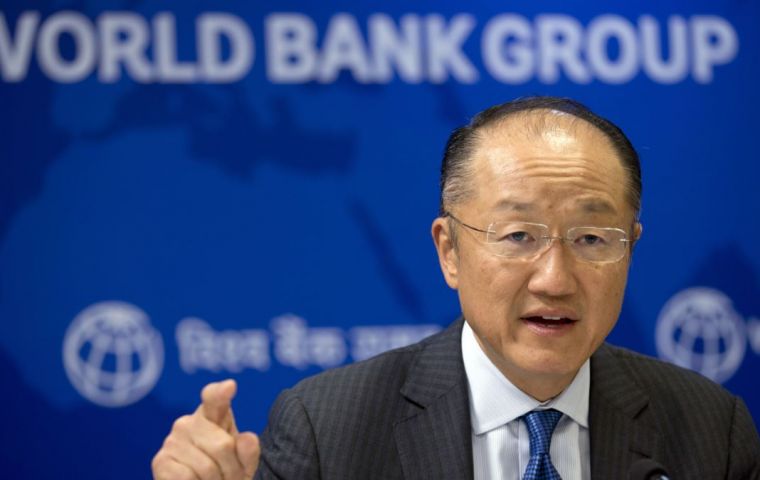MercoPress. South Atlantic News Agency
Great recession almost over, “but no time for complacency”, warns World Bank
 “The broad-based recovery in global growth is encouraging, but this is no time for complacency,” World Bank Group president Jim Yong Kim said.
“The broad-based recovery in global growth is encouraging, but this is no time for complacency,” World Bank Group president Jim Yong Kim said.  The slowdown in potential growth is the result of years of softening productivity growth, weak investment, and the aging of the global labor force.
The slowdown in potential growth is the result of years of softening productivity growth, weak investment, and the aging of the global labor force. The World Bank forecasts global economic growth to edge up to 3.1% in 2018 after a much stronger-than-expected 2017, as the recovery in investment, manufacturing, and trade continues, and as commodity-exporting developing economies benefit from firming commodity prices.
However, this is largely seen as a short-term upswing. Over the longer term, slowing potential growth—a measure of how fast an economy can expand when labor and capital are fully employed—puts at risk gains in improving living standards and reducing poverty around the world, the World Bank warns in its January 2018 Global Economic Prospects.
Growth in advanced economies is expected to moderate slightly to 2.2% in 2018, as central banks gradually remove their post-crisis accommodation and as an upturn in investment levels off. Growth in emerging market and developing economies as a whole is projected to strengthen to 4.5% in 2018, as activity in commodity exporters continues to recover.
“The broad-based recovery in global growth is encouraging, but this is no time for complacency,” World Bank Group president Jim Yong Kim said. “This is a great opportunity to invest in human and physical capital. If policy makers around the world focus on these key investments, they can increase their countries’ productivity, boost workforce participation, and move closer to the goals of ending extreme poverty and boosting shared prosperity.”
2018 is on track to be the first year since the financial crisis that the global economy will be operating at or near full capacity. With slack in the economy expected to dissipate, policymakers will need to look beyond monetary and fiscal policy tools to stimulate short-term growth and consider initiatives more likely to boost long-term potential.
The slowdown in potential growth is the result of years of softening productivity growth, weak investment, and the aging of the global labor force. The deceleration is widespread, affecting economies that account for more than 65% of global GDP. Without efforts to revitalize potential growth, the decline may extend into the next decade, and could slow average global growth by a quarter percentage point and average growth in emerging market and developing economies by half a percentage point over that period.
Risks to the outlook remain tilted to the downside. An abrupt tightening of global financing conditions could derail the expansion. Escalating trade restrictions and rising geopolitical tensions could dampen confidence and activity. On the other hand, stronger-than-anticipated growth could also materialize in several large economies, further extending the global upturn.
“With unemployment rates returning to pre-crisis levels and the economic picture brighter in advanced economies and the developing world alike, policymakers will need to consider new approaches to sustain the growth momentum,” said World Bank Development Economics Prospects Director Ayhan Kose. “Specifically, productivity-enhancing reforms have become urgent as the pressures on potential growth from aging populations intensify.”
In addition to exploring developments at the global and regional levels, the January 2018 Global Economic Prospects takes a close look at the outlook for potential growth in each of the six global regions; lessons from the 2014-2016 oil price collapse; and the connection between higher levels of skill and education and lower levels of inequality in emerging market and developing economies.
More specifically in Latin America and the Caribbean growth is projected to advance to 2% in 2018, from an estimated 0.9% in 2017. Growth momentum is expected to gather as private consumption and investment strengthen, particularly among commodity-exporting economies. Additional policy uncertainty, natural disasters, a rise in trade protectionism in the United States, or further deterioration of domestic fiscal conditions could throw growth off course. Brazil is expected to pick up to 2% in 2018, from an estimated 1% in 2017. Mexico is anticipated to accelerate to 2.1% this year, from an estimated 1.9% in 2017.




Top Comments
Disclaimer & comment rulesCommenting for this story is now closed.
If you have a Facebook account, become a fan and comment on our Facebook Page!